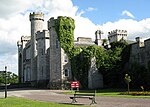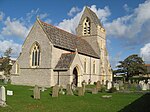Kinmel Park Training Area
AbergeleHistory of Conwy County BoroughUse British English from August 2022Wales in World War I
Kinmel Park Training Area is an army training ground in what was once the grounds of Kinmel Hall, near Abergele, in Conwy county borough, Wales. The camp was built in 1915 to train troops during the First World War and was later used to house troops at the end of the conflict. A riot broke out in the camp among Canadian forces in 1919, leading to the deaths of several soldiers. The camp was downscaled after the war, being reduced to around half of its original size.
Excerpt from the Wikipedia article Kinmel Park Training Area (License: CC BY-SA 3.0, Authors).Kinmel Park Training Area
Ffordd Rufeinig,
Geographical coordinates (GPS) Address Nearby Places Show on map
Geographical coordinates (GPS)
| Latitude | Longitude |
|---|---|
| N 53.265 ° | E -3.529 ° |
Address
Ffordd Rufeinig
LL22 9RR , Abergele
Wales, United Kingdom
Open on Google Maps










